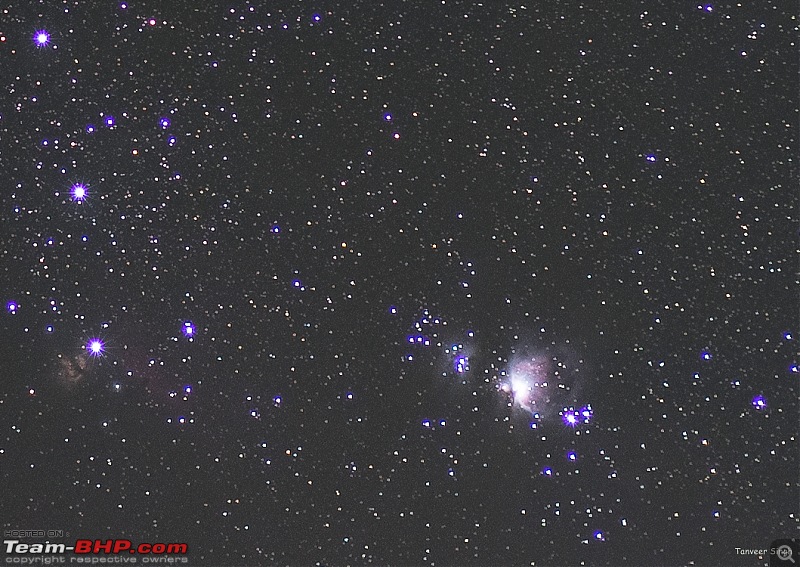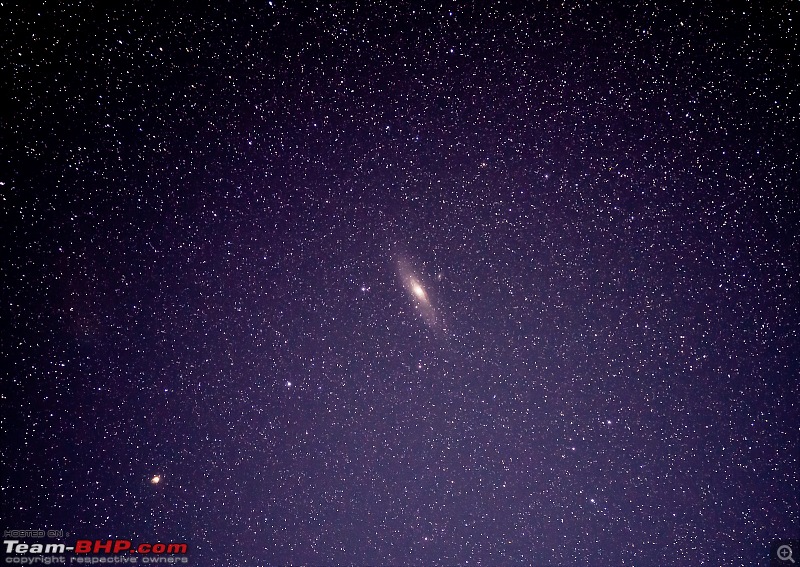Team-BHP
(
https://www.team-bhp.com/forum/)
After the great success of our country's mars orbital mission and watching interstellar, I have become interested in the dark sky. And there is an urge to capture it, through the lens ofcourse! I have read various forum and gathered the photography equipment required. The only thing I have no clue about is the location.
A cloudless night sky with absolutely no light, not even the moon should be present. There should be no or atleast minimum city light pollution possible.
Though it's related to photography, I think astronomy guys would be able to help me better. Please tell me a few good locations where I could take some good photos around delhi or udaipur or any where you would have tried.
Another question which if not answered will be fine - what are your thoughts about the science behind interstellar?
Thanks
Good luck with star gazing :thumbs up
Guys, need help - URGENT !
I want to know on which days in Bangalore is the sun exactly above. I think this will be once between March-21 & June-21 and again sometime between June & September.
Quote:
Originally Posted by condor
(Post 3628377)
Guys, need help - URGENT !
I want to know on which days in Bangalore is the sun exactly above. I think this will be once between March-21 & June-21 and again sometime between June & September.
|
24th April is the first date.
Second date you can locate by spending some time on this page
http://suncalc.net/#/12.8546,77.6074,5/2015.04.24/12:23 Quote:
Originally Posted by 4k_jz
(Post 3585169)
After the great success of our country's mars orbital mission and watching interstellar, I have become interested in the dark sky. And there is an urge to capture it, through the lens ofcourse! I have read various forum and gathered the photography equipment required. The only thing I have no clue about is the location.
A cloudless night sky with absolutely no light, not even the moon should be present. There should be no or atleast minimum city light pollution possible.
Though it's related to photography, I think astronomy guys would be able to help me better. Please tell me a few good locations where I could take some good photos around delhi or udaipur or any where you would have tried.
Another question which if not answered will be fine - what are your thoughts about the science behind interstellar?
Thanks
Good luck with star gazing :thumbs up
|
you have to go to a dark sky location
http://www.lightpollutionmap.info/#z...ayers=B0TFFFTT
Rest is just simple weather game.
I clicked the Orion nebula(faint horsehead also visible) from Munsiyari
My attempt quality is not upto the mark. Will try again soon, with better polar alignment and some more Dark and flat frames to get higher contrast. Aim is to get the Barnards loop. Do not have any CLS filters though, will be tough unless the skies are really really clear

That said, another simpler object is the Andromeda
With a 50mm lens 8 seconds exposure and ISO 3200 at F2.0, you can get a decent shot even without tracking.
That said, this is with tracking, again very few frames. Will try and do better

Hi All,
Since we are on the astronomy thread I want to ask a question to which I know the answer (I love everything science)
Q: Imagine that the sun disappears from the sky right now. It doesn't fade away, it doesn't make a noise, it doesn't give us any indication. It just disappears. It is no longer there in the sky.
So how long does it take for us, people on earth, to realize that the sun disappeared?
Quote:
Originally Posted by SyncNest
(Post 3628490)
Hi All,
Since we are on the astronomy thread I want to ask a question to which I know the answer (I love everything science)
Q: Imagine that the sun disappears from the sky right now. It doesn't fade away, it doesn't make a noise, it doesn't give us any indication. It just disappears. It is no longer there in the sky.
So how long does it take for us, people on earth, to realize that the sun disappeared?
|
Here you go
The complete answer
https://www.youtube.com/watch?v=rltpH6ck2Kc
Quote:
Originally Posted by tsk1979
(Post 3628411)
you have to go to a dark sky location http://www.lightpollutionmap.info/#z...ayers=B0TFFFTT
That said, another simpler object is the Andromeda
With a 50mm lens 8 seconds exposure and ISO 3200 at F2.0, you can get a decent shot even without tracking.
That said, this is with tracking, again very few frames. Will try and do better
|
That link will be of great help! Thanks:thumbs up
The Andromeda capture is a nice one.
Are you using a crop sensor or a full frame?
Because a 50mm on crop would be like 75mm and hence smaller frame capture.
I was thinking of using a Canon 24mm f2.8 efs with Canon 600d. That would give me around 38mm focal length. Any other lens suggestion?
Quote:
Originally Posted by tsk1979
(Post 3628411)
|
Thanks, TSK. I was checking another site, where the closest I seemed to get was a little off-top at 12:00 PM. This URL says solar noon is at 12:18 PM. Guess that was the difference.
But thanks for the link ..
Question:
Why is Solar noon different than 12:00 PM ?
Quote:
Originally Posted by condor
(Post 3628757)
Thanks, TSK. I was checking another site, where the closest I seemed to get was a little off-top at 12:00 PM. This URL says solar noon is at 12:18 PM. Guess that was the difference.
But thanks for the link ..
Question:
Why is Solar noon different than 12:00 PM ?
|
Because 12:00 is noon at the Indian Standard time longitude. Every other longitude gets noon at different time
Beagle 2, the British spacecraft lost for over 11 years, has been located intact on the surface of Mars:
http://en.wikipedia.org/wiki/Beagle_2#Discovery Quote:
Images suggest that one of the "petals" on which the solar panels of the lander are mounted, failed to fully open, preventing deployment of its radio antenna, blocking communication.
|
A few days ago, I had asked what date would the sun be right above, at Bangalore. Thanks to TSK who had responded to that.
Another question:
On March 21 & Sept 23, the sun's path would be aligned with the equator. So if a person is standing on the equator, is facing East / the sun, then his shadow would move from west to east with the course of the day - In a straight line. At mid-day, his shadow would be minimal - since the sun is right above.
Now, the question:
Is such a thing possible at any other latitude on the Earth ?
To keep it simple, since I am in BLR, can this happen at BLR also ?
Trying TBHP as the last rescue.
Can anyone, with the help of simple examples explain me the theory of relativity, time dilation and the concept of space-time?
I have tried reading stuff over internet again and again but the concept is not getting into my thick head. I would be really obliged to you guys here if you help me understanding it.
Thanks in anticipation of help.
PS: Yes, it's the Interstellar effect.:D However, these questions have bothered me for long.
Quote:
Originally Posted by condor
(Post 3632591)
On March 21 & Sept 23, the sun's path would be aligned with the equator. So if a person is standing on the equator, is facing East / the sun, then his shadow would move from west to east with the course of the day - In a straight line. At mid-day, his shadow would be minimal - since the sun is right above.
Now, the question:
Is such a thing possible at any other latitude on the Earth ?
|
Of course yes.
As long as you are at a place which is between the tropic of cancer and the tropic of capicorn!
This is the whole concept behind the notion of tropics.
Quote:
Originally Posted by saket77
(Post 3703064)
Can anyone, with the help of simple examples explain me the theory of relativity, time dilation and the concept of space-time?
I have tried reading stuff over internet again and again but the concept is not getting into my thick head. I would be really obliged to you guys here if you help me understanding it.
|
Let me try to ask you a question:
Q1: IF you a traveling at speed of X (with reference to say a distant "stationary" star), and you throw a ball directly ahead at speed of Y, what would be the speed of this ball (with reference to say a distant "stationary" star)?
A1: X+Y
Q2: What happens in case instead of throwing ball, you switched on your headlights. Does the light beam also travel at X+Y?
A2: ___
Quote:
Originally Posted by alpha1
(Post 3704152)
Let me try to ask you a question:
Q1: IF you a traveling at speed of X (with reference to say a distant "stationary" star), and you throw a ball directly ahead at speed of Y, what would be the speed of this ball (with reference to say a distant "stationary" star)?
A1: X+Y
Q2: What happens in case instead of throwing ball, you switched on your headlights. Does the light beam also travel at X+Y?
A2: ___
|
First of all thanks Alpha for the courage :D Courage as not for answering the question, but for trying making me understand!:)
Coming to your question, I think the answer is Only Y and not X+Y because speed of light is constant. I don't know the logic behind this, but this is from what I have read. I may have misread and I may be wrong though.
Thanks!
Quote:
Originally Posted by saket77
(Post 3704162)
I think the answer is Only Y and not X+Y because speed of light is constant.
|
Q1: Why?
More important:
Q2: In the first example why did we assume that the ball's velocity will be X+Y?
Quote:
Originally Posted by alpha1
(Post 3704262)
Q1: Why?
|
No idea why the speed of light does not change in this example. I am not even sure if I am right.
Quote:
Originally Posted by alpha1
(Post 3704262)
More important:
Q2: In the first example why did we assume that the ball's velocity will be X+Y?
|
As for a stationery observer outside of the car, the ball is traveling at the speed of the car. But for someone inside the car, the ball is stationery and is not moving. So, probably when thrown outside, X+Y?
| All times are GMT +5.5. The time now is 15:17. | |



